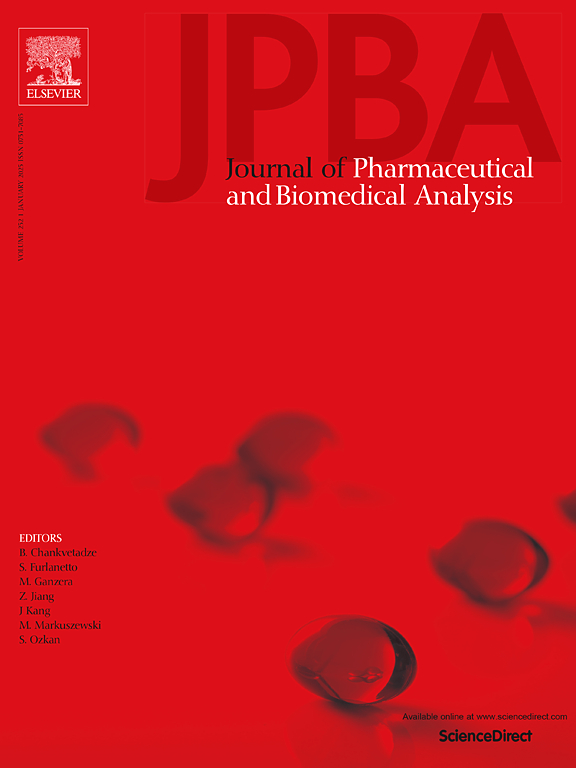Analytical quality by design and measurement uncertainty in the development of discriminative dissolution method for pediatric fixed-dose combination dispersible tablets of isoniazid and rifampicin
IF 3.1
3区 医学
Q2 CHEMISTRY, ANALYTICAL
Journal of pharmaceutical and biomedical analysis
Pub Date : 2025-05-27
DOI:10.1016/j.jpba.2025.116994
引用次数: 0
Abstract
Analytical Quality by Design (AQbD) is a proactive approach that ensures the consistent performance of analytical methods throughout the lifecycle. The application of AQbD in dissolution testing remains limited, particularly with the incorporation of measurement uncertainty to minimize risks for both consumers and producers. This study applied AQbD principles to develop a dissolution method for a fixed-dose combination of isoniazid (INH) and rifampicin (RIF) in dispersible tablets. The Analytical Target Profile was defined based on the dissolved percentage of INH and RIF. A risk-based approach was used to assess risks impacting the discriminative power and measurement uncertainty. design of experiments optimized medium pH, volume and rotation speed, considering two experimental batches. With Monte Carlo simulations, the Method Operable Design Region was constructed to allow batch A approval and batch B failure. Validation confirmed that the methods were selective, precise and accurate, with combined standard uncertainties of 1.7 % for INH and 3.8 % for RIF. The guard bands defined new acceptance limits in the three stages of dissolution, minimizing both consumer and producer risks. A hazard analysis and critical control point plan was established as a control strategy. If the dissolved percentage of RIF or INH leads to a batch failure, two options are possible: retesting or discarding the batch, considering guard bands to ensure a producer risk lower than 5 %. The study innovates by demonstrating the relevance of incorporating AQbD in dissolution testing, ensuring more reliable methods for controlling product quality.
异烟肼和利福平小儿固定剂量联合分散片判别溶出度方法的设计与测定不确定度分析质量
分析质量设计(AQbD)是一种前瞻性的方法,确保分析方法在整个生命周期中的一致性能。AQbD在溶出度检测中的应用仍然有限,特别是在纳入测量不确定度以尽量减少消费者和生产者风险的情况下。本研究应用AQbD原理建立了异烟肼(INH)和利福平(RIF)在分散片中固定剂量联合溶出度的测定方法。根据INH和RIF的溶解百分比定义分析目标剖面。采用基于风险的方法评估影响判别能力和测量不确定性的风险。实验设计考虑两个实验批次,优化培养基pH、体积和转速。通过蒙特卡罗模拟,构建了允许批A批准和批B失败的方法可操作设计区域。验证方法选择性好、精密度高、准确度高,INH的标准不确定度为1.7 %,RIF的标准不确定度为3.8 %。保护带在三个溶解阶段定义了新的可接受限度,以尽量减少消费者和生产者的风险。制定了危害分析和关键控制点计划作为控制策略。如果RIF或INH的溶解百分比导致批次失败,则可能有两种选择:重新测试或丢弃该批次,考虑保护带以确保生产者风险低于5% %。该研究通过展示将AQbD纳入溶出度测试的相关性,确保更可靠的方法来控制产品质量。
本文章由计算机程序翻译,如有差异,请以英文原文为准。
求助全文
约1分钟内获得全文
求助全文
来源期刊
CiteScore
6.70
自引率
5.90%
发文量
588
审稿时长
37 days
期刊介绍:
This journal is an international medium directed towards the needs of academic, clinical, government and industrial analysis by publishing original research reports and critical reviews on pharmaceutical and biomedical analysis. It covers the interdisciplinary aspects of analysis in the pharmaceutical, biomedical and clinical sciences, including developments in analytical methodology, instrumentation, computation and interpretation. Submissions on novel applications focusing on drug purity and stability studies, pharmacokinetics, therapeutic monitoring, metabolic profiling; drug-related aspects of analytical biochemistry and forensic toxicology; quality assurance in the pharmaceutical industry are also welcome.
Studies from areas of well established and poorly selective methods, such as UV-VIS spectrophotometry (including derivative and multi-wavelength measurements), basic electroanalytical (potentiometric, polarographic and voltammetric) methods, fluorimetry, flow-injection analysis, etc. are accepted for publication in exceptional cases only, if a unique and substantial advantage over presently known systems is demonstrated. The same applies to the assay of simple drug formulations by any kind of methods and the determination of drugs in biological samples based merely on spiked samples. Drug purity/stability studies should contain information on the structure elucidation of the impurities/degradants.

 求助内容:
求助内容: 应助结果提醒方式:
应助结果提醒方式:


